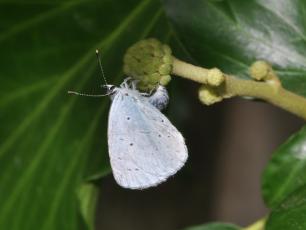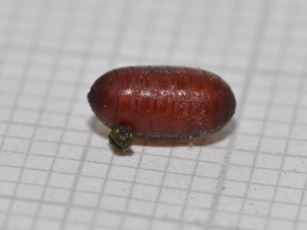The holly blue butterfly
Whilst many species of butterfly visit our garden, one of the most fascinating is the Holly Blue (Celastrina argiolus). This is partly because both the adult butterflies and the eggs are fairly photogenic (the caterpillars leave something to be desired in this respect, and the pupae are simply boring). Chasing around trying to find eggs and caterpillars on ivy flower buds is a long, slow job - the eggs are very small and the larvae are well camouflaged. But it's worth it when you find an egg in a position which can be photographed. The other interesting thing about this species is that it has two generations each year, but with different larval food plants for each generation. Eggs laid in the spring (from April onwards in the southern parts of the UK) are laid on holly (Ilex spp.); those laid in the summer (July/August) are on Ivy (Hedera helix). There is also a strong relationship between populations of the holly blue and a wasp which parasitises only this species. This page is dedicated to photographs of the holly blue (and its parasites) taken in our garden.
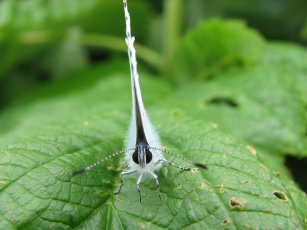 This is an adult holly blue butterfly. Perhaps not the classic view you'd expect in a butterfly photo, but I've not (yet!) managed to get a decent photo showing the upperside of the wings.
They're a lovely blue colour from above, with a black edge to the blue and then a white border around the edge of the wing. The only difference in pattern between the sexes is that the female
has a dark tip to each wing on the upper side; in the male, there is just a slight widening of the dark line which surrounds the blue area.
This is an adult holly blue butterfly. Perhaps not the classic view you'd expect in a butterfly photo, but I've not (yet!) managed to get a decent photo showing the upperside of the wings.
They're a lovely blue colour from above, with a black edge to the blue and then a white border around the edge of the wing. The only difference in pattern between the sexes is that the female
has a dark tip to each wing on the upper side; in the male, there is just a slight widening of the dark line which surrounds the blue area.
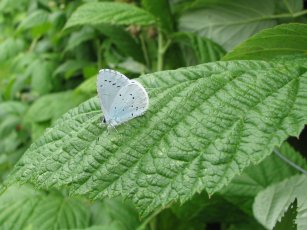 This shows the underside of the wing. It isn't possible to tell from the pattern whether this is a male or a female. If the abdomen were more visible, this would give a clue (the female is fatter).
This shows the underside of the wing. It isn't possible to tell from the pattern whether this is a male or a female. If the abdomen were more visible, this would give a clue (the female is fatter).
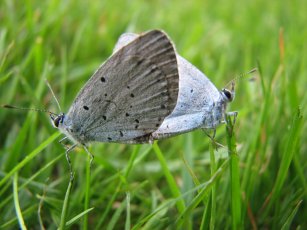 I found this pair mating on the lawn - fortunately, they remained there long enough for me to get my camera.
I found this pair mating on the lawn - fortunately, they remained there long enough for me to get my camera.
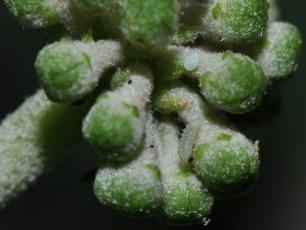 The eggs for the summer generation of holly blue are laid on ivy flower buds. This photo shows both an egg and a caterpillar. As noted above, holly blue caterpillars are not the most beautiful,
but the egg is wonderfully sculpted. The caterpillar's head is relatively small for its size (it's head is black, and visible at the lower end of the body in this photo). This allows it to
feed by hollowing out individual flower buds, as in the photo further down this page.As with most of the photos on these pages, click on the image here to see a larger version, and again
on the "full screen" symbol on the lower right of that version to see the full resolution image.
The eggs for the summer generation of holly blue are laid on ivy flower buds. This photo shows both an egg and a caterpillar. As noted above, holly blue caterpillars are not the most beautiful,
but the egg is wonderfully sculpted. The caterpillar's head is relatively small for its size (it's head is black, and visible at the lower end of the body in this photo). This allows it to
feed by hollowing out individual flower buds, as in the photo further down this page.As with most of the photos on these pages, click on the image here to see a larger version, and again
on the "full screen" symbol on the lower right of that version to see the full resolution image.
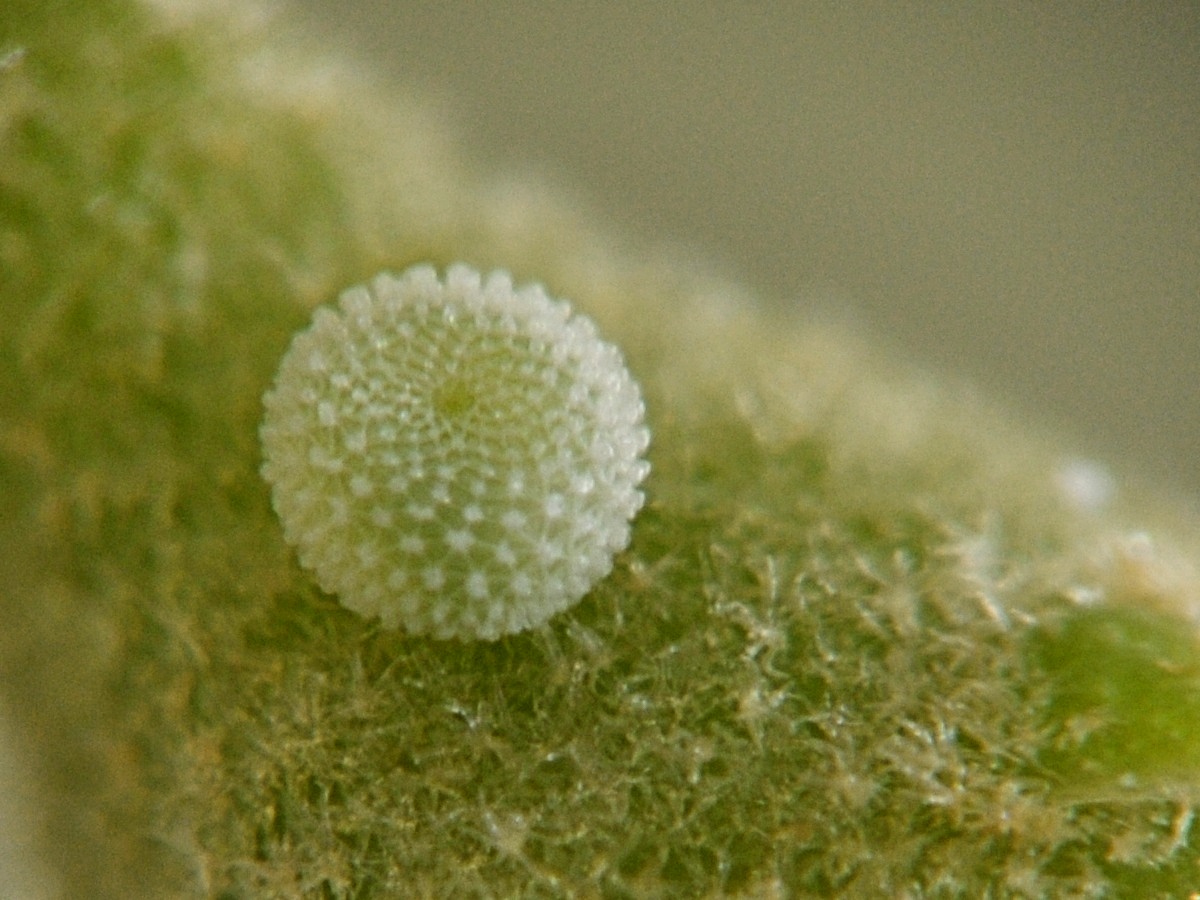 This photo shows more detail of the sculptured surface of the holly blue egg. I took it by holding an old Pentax 35mm lens reversed against the protective cover glass on the front of a 105mm focal
length lens, to provide additional magnification. I selected a very small aperture (F29) to
maximise the depth of focus. It was taken hand-held, and gives a fair idea of the amazing shape of the egg (it can't be much fun to lay something this shape - I wonder if it starts smooth
and then shrinks down?). Although some much better images are available on the web, they have been produced by combining many separate photos in a process known as focus stacking.
This photo shows more detail of the sculptured surface of the holly blue egg. I took it by holding an old Pentax 35mm lens reversed against the protective cover glass on the front of a 105mm focal
length lens, to provide additional magnification. I selected a very small aperture (F29) to
maximise the depth of focus. It was taken hand-held, and gives a fair idea of the amazing shape of the egg (it can't be much fun to lay something this shape - I wonder if it starts smooth
and then shrinks down?). Although some much better images are available on the web, they have been produced by combining many separate photos in a process known as focus stacking.
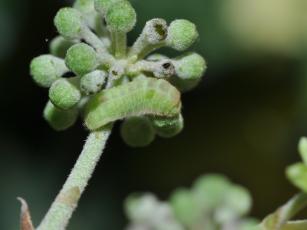 This caterpillar is just about fully grown, and is starting to show some of the red colouration which often precedes pupation. You can see the typical feeding damage on the ivy flower buds - individual buds
are hollowed out, with a relatively small hole to one side.
This caterpillar is just about fully grown, and is starting to show some of the red colouration which often precedes pupation. You can see the typical feeding damage on the ivy flower buds - individual buds
are hollowed out, with a relatively small hole to one side.
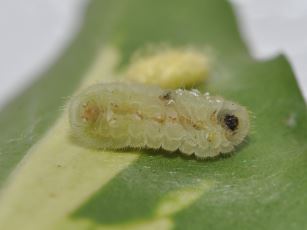 In late 2012, we decided to remove a "golden heart" ivy plant from the wall of our house, as it had grown far too large. We checked all the flower stalks, and found caterpillars on two of them, so
brought them indoors and put them in a terrarium to allow the caterpillars to pupate. But, shortly before they were ready, a yellow cocoon appeared on a leaf where one caterpillar had been; the
caterpillar had fallen to the bottom of the terrarium and was almost dead (and looking somewhat "deflated") - it had clearly been parasitised. And the other caterpillar had started to spin the web
for its cocoon, but had then stopped, and a smooth pupa had fallen from the caterpillar skin to the floor of the terrarium. This photo shows the first caterpillar on the leaf with the
parasitoid cocoon in the background.
In late 2012, we decided to remove a "golden heart" ivy plant from the wall of our house, as it had grown far too large. We checked all the flower stalks, and found caterpillars on two of them, so
brought them indoors and put them in a terrarium to allow the caterpillars to pupate. But, shortly before they were ready, a yellow cocoon appeared on a leaf where one caterpillar had been; the
caterpillar had fallen to the bottom of the terrarium and was almost dead (and looking somewhat "deflated") - it had clearly been parasitised. And the other caterpillar had started to spin the web
for its cocoon, but had then stopped, and a smooth pupa had fallen from the caterpillar skin to the floor of the terrarium. This photo shows the first caterpillar on the leaf with the
parasitoid cocoon in the background.
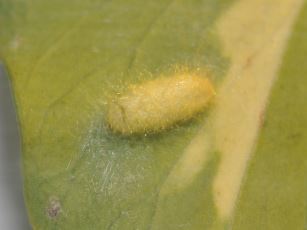 This is the cocoon from the photo above. I kept it in a petri dish so that I could see what emerged. This photograph was taken after the adult parasitoid had emerged.
This is the cocoon from the photo above. I kept it in a petri dish so that I could see what emerged. This photograph was taken after the adult parasitoid had emerged.
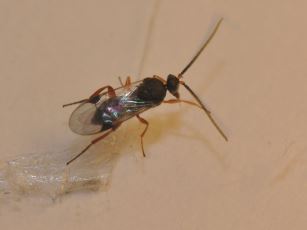 And this is the parasitoid which appeared from the cocoon above. I think it is most probably Cotesia inducta though this hasn't been confirmed by an expert. If so, this is interesting, as this species
is reported as a relatively recent arrival in the UK (2005). It is reported as a parasitoid of the holly blue butterfly, but most articles concentrate on another species of parasitic wasp,
Listrodromus nycthemerus, which is reported to be the cause of repeated crashes in the UK population of the butterfly. You can't help wondering what the effect of this new parasitoid will be on UK populations
of the holly blue.
And this is the parasitoid which appeared from the cocoon above. I think it is most probably Cotesia inducta though this hasn't been confirmed by an expert. If so, this is interesting, as this species
is reported as a relatively recent arrival in the UK (2005). It is reported as a parasitoid of the holly blue butterfly, but most articles concentrate on another species of parasitic wasp,
Listrodromus nycthemerus, which is reported to be the cause of repeated crashes in the UK population of the butterfly. You can't help wondering what the effect of this new parasitoid will be on UK populations
of the holly blue.
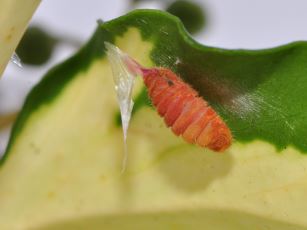 This is the remains of the second caterpillar mentioned earlier. It had just started to spin some silk for its cocoon when it split open and a parasitoid pupa fell from the empty skin.
This is the remains of the second caterpillar mentioned earlier. It had just started to spin some silk for its cocoon when it split open and a parasitoid pupa fell from the empty skin.
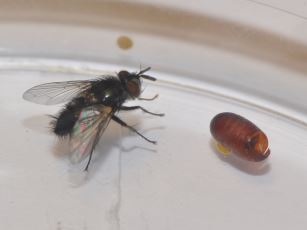 This is the fly which emerged from the pupa. A search on the web turned up a couple of species of Tachinid flies known to parasitise holly blue larvae (Aplomya confinis and Phryxe magnicornis) but
I'm not expert enough to tell which of these (if either) it might be. But the final point worth noting is that both the caterpillars we found proved to parasitised, but neither with the widely reported species
which is supposed to be the major parasitoid of the larvae of this butterfly in the UK.
This is the fly which emerged from the pupa. A search on the web turned up a couple of species of Tachinid flies known to parasitise holly blue larvae (Aplomya confinis and Phryxe magnicornis) but
I'm not expert enough to tell which of these (if either) it might be. But the final point worth noting is that both the caterpillars we found proved to parasitised, but neither with the widely reported species
which is supposed to be the major parasitoid of the larvae of this butterfly in the UK.
